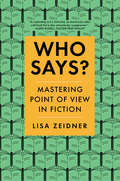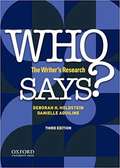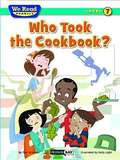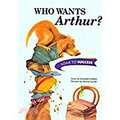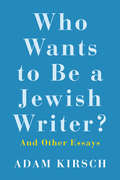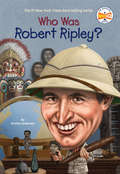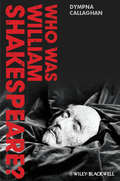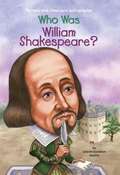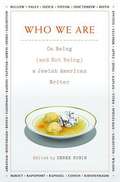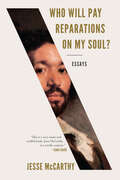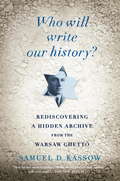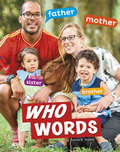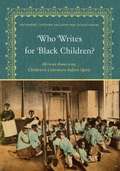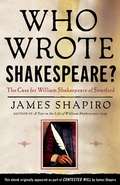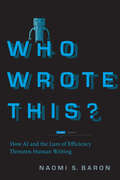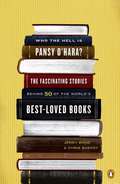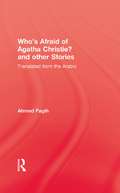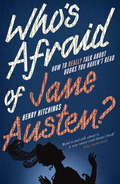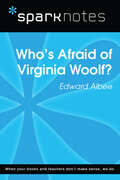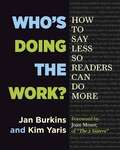- Table View
- List View
Who Says?: Mastering Point Of View In Fiction
by Lisa ZeidnerA thorough, illuminating, and entertaining guide to crafting point of view, a fiction writer’s most essential choice. Who is telling the story to whom is the single most important question about any work of fiction; the answer is central to everything from style and tone to plot and pacing. Using hundreds of examples from Jane Austen to Chimamanda Ngozi Adichie, Leo Tolstoy to Stephen King, novelist and longtime MFA professor Lisa Zeidner dives deep into the points of view we are most familiar with—first and third person—and moves beyond to second-person narration, frame tales, and even animal points of view. Engaging and accessible, Who Says? presents any practicing writer with a new system for choosing a point of view, experimenting with how it determines the narrative, and applying these ideas to revision.
Who Says?: The Writer's Research
by Danielle Aquiline Deborah H. HoldsteinNow in a new edition, Who Says? The Writer's Research is an innovative and brief research guide focusing on information literacy. The text shows students not only how to do research but also why research is important. <p><p> Written for today's college student, Who Says? addresses contemporary research issues head on: <p><p> - What does it mean to conduct research in an age when we are bombarded by collaborative information through online media and databases like Wikipedia? - Who owns this information? How do we know? - As information circulates and changes, do the lines between audience and author blur? - How should these changes alter our expectations as readers and as writers? <p><p> By prompting students to think critically about matters of ownership and authority, Who Says? not only shows students how to find and incorporate credible sources in their writing, but also encourages students to synthesize their own ideas with the ideas of others, leading them to develop more confident and compelling voices as writers.
Who Took the Cookbook?
by Kelly Light Paul OrshoskiThe cook in the lunchroom usually serves great food, but now her cookbook and all her recipes are missing and her food is just awful! Students join in the hunt to find her missing cookbook in this fun story with a surprise ending. This humorous title offers engaging phonics practice and fun phonics games.
Who Wants to Be a Jewish Writer?: And Other Essays
by Adam KirschFrom one of today’s keenest critics comes a collection of essays on poetry, religion, and the connection between the two Adam Kirsch is one of today’s finest literary critics. This collection brings together his essays on poetry, religion, and the intersections between them, with a particular focus on Jewish literature. He explores the definition of Jewish literature, the relationship between poetry and politics, and the future of literary reputation in the age of the internet. Several essays look at the way Jewish writers such as Stefan Zweig and Isaac Deutscher, who coined the phrase “the non‑Jewish Jew,” have dealt with politics. Kirsch also examines questions of spirituality and morality in the writings of contemporary poets, including Christian Wiman, Kay Ryan, and Seamus Heaney. He closes by asking why so many American Jewish writers have resisted that category, inviting us to consider “Is there such a thing as Jewish literature?”
Who Was Robert Ripley? (Who was?)
by Nancy Harrison Kirsten Anderson Tim FoleyEnter a world of shrunken heads, mystic holy men, shriveled aliens, and bizarre relics in the delightfully odd tale of Robert Ripley. Born in California, Ripley began his career as a sports cartoonist. He went on to chronicle global records and oddities in his weekly column, Believe It Or Not! After publishing mogul William Randolph Hearst took an interest in the column, it became a syndicated global success. Ripley spent his life traveling to more than 200 countries in search of strange objects and interesting facts. His penchant for the peculiar launched an entertainment empire, and his collection of artifacts can be seen worldwide at his famous Odditoriums. Believe It Or Not!
Who Was William Shakespeare
by Dympna CallaghanA new study of Shakespeare's life and times, which illuminates our understanding and appreciation of his works.Combines an accessible fully historicised treatment of both the life and the plays, suited to both undergraduate and popular audiencesLooks at 24 of the most significant plays and the sonnets through the lens of various aspects of Shakespeare's life and historical environmentAddresses four of the most significant issues that shaped Shakespeare's career: education, religion, social status, and theatreExamines theatre as an institution and the literary environment of early modern LondonExplains and dispatches conspiracy theories about authorship
Who Was William Shakespeare?
by Celeste Davidson MannisThe beloved plays of Shakespeare are still produced everywhere, yet the life of the world's most famous playwright remains largely a mystery. Young Will left the town of Stratford to pursue theatre in London, where his work eventually thrived and made him a famous and wealthy man. Celeste Davidson Mannis puts together the pieces of Shakespeare's life and work for young readers.
Who We Are: On Being (and Not Being) A Jewish American Writer
by Derek RubinThis unprecedented collection brings together the major Jewish American writers of the past fifty years as they examine issues of identity and how they've made their work respond. E. L. Doctorow questions the very notion of the Jewish American writer, insisting that all great writing is secular and universal. Allegra Goodman embraces the categorization, arguing that it immediately binds her to her readers. Dara Horn, among the youngest of these writers, describes the tendency of Jewish writers to focus on anti-Semitism and advocates a more creative and positive way of telling the Jewish story. Thane Rosenbaum explains that as a child of Holocaust survivors, he was driven to write in an attempt to reimagine the tragic endings in Jewish history. Here are the stories of how these writers became who they are: Saul Bellow on his adolescence in Chicago, Grace Paley on her early love of Romantic poetry, Chaim Potok on being transformed by the work of Evelyn Waugh. Here, too, are Philip Roth, Cynthia Ozick, Erica Jong, Jonathon Rosen, Tova Mirvis, Pearl Abraham, Alan Lelchuk, Rebecca Goldstein, Nessa Rapoport, and many more. Spanning three generations of Jewish writing in America, these essays -- by turns nostalgic, comic, moving, and deeply provocative- constitute an invaluable investigation into the thinking and the work of some of America's most important writers.
Who We're Reading When We're Reading Murakami
by David KarashimaHow did a loner destined for a niche domestic audience become one of the most famous writers alive? A "fascinating" look at the "business of bringing a best-selling novelist to a global audience" (The Atlantic)―and a “rigorous” exploration of the role of translators and editors in the creation of literary culture (The Paris Review). Thirty years ago, when Haruki Murakami’s works were first being translated, they were part of a series of pocket-size English-learning guides released only in Japan. Today his books can be read in fifty languages and have won prizes and sold millions of copies globally. How did a loner destined for a niche domestic audience become one of the most famous writers alive? This book tells one key part of the story. Its cast includes an expat trained in art history who never intended to become a translator; a Chinese American ex-academic who never planned to work as an editor; and other publishing professionals in New York, London, and Tokyo who together introduced a pop-inflected, unexpected Japanese voice to the wider literary world. David Karashima synthesizes research, correspondence, and interviews with dozens of individuals—including Murakami himself—to examine how countless behind-the-scenes choices over the course of many years worked to build an internationally celebrated author’s persona and oeuvre. His careful look inside the making of the “Murakami Industry" uncovers larger questions: What role do translators and editors play in framing their writers’ texts? What does it mean to translate and edit “for a market”? How does Japanese culture get packaged and exported for the West?
Who Will Pay Reparations on My Soul?: Essays
by Jesse McCarthy"This is a very smart and soulful book. Jesse McCarthy is a terrific essayist." —Zadie Smith New York Times • "New Books to Watch For in March" A supremely talented young critic’s essays on race and culture, from Toni Morrison to trap, herald the arrival of a major new voice in American letters. Ranging from Ta-Nehisi Coates’s case for reparations to Toni Morrison’s revolutionary humanism to D’Angelo’s simmering blend of R&B and racial justice, Jesse McCarthy’s bracing essays investigate with virtuosic intensity the art, music, literature, and political stances that have defined the twenty-first century. Even as our world has suffered through successive upheavals, McCarthy contends, “something was happening in the world of culture: a surging and unprecedented visibility at every level of black art making.” Who Will Pay Reparations on My Soul? reckons with this resurgence, arguing for the central role of art and intellectual culture in an age of widening inequality and moral crisis. McCarthy reinvigorates the essay form as a space not only for argument but for experimental writing that mixes and chops the old ways into new ones. In “Notes on Trap,” he borrows a conceit from Susan Sontag to reveal the social and political significance of trap music, the drug-soaked strain of Southern hip-hop that, as he puts it, is “the funeral music that the Reagan Revolution deserves.” In “Back in the Day,” McCarthy, a black American raised in France, evokes his childhood in Paris through an elegiac account of French rap in the 1990s. In “The Master’s Tools,” the relationship between Spanish painter Diego Velázquez and his acolyte-slave, Juan de Pareja, becomes the lens through which Kehinde Wiley’s paintings are viewed, while “To Make a Poet Black” explores the hidden blackness of Sappho and the erotic power of Phillis Wheatley. Essays on John Edgar Wideman, Claudia Rankine, and Colson Whitehead survey the state of black letters. In his title essay, McCarthy takes on the question of reparations, arguing that true progress will not come until Americans remake their institutions in the service of true equality. As he asks, “What can reparations mean when the damage cannot be accounted for in the only system of accounting that a society recognizes?” For readers of Teju Cole’s Known and Strange Things and Mark Greif’s Against Everything, McCarthy’s essays portray a brilliant young critic at work, making sense of our disjointed times while seeking to transform our understanding of race and art, identity and representation.
Who Will Write Our History?: Rediscovering a Hidden Archive from the Warsaw Ghetto
by Samuel D. KassowIn 1940, in the Jewish ghetto of Nazi-occupied Warsaw, the Polish historian Emanuel Ringelblum established a clandestine scholarly organization called the Oyneg Shabes to record the experiences of the ghetto's inhabitants. For three years, members of the Oyneb Shabes worked in secret to chronicle the lives of hundereds of thousands as they suffered starvation, disease, and deportation by the Nazis. Shortly before the Warsaw ghetto was emptied and razed in 1943, the Oyneg Shabes buried thousands of documents from this massive archive in milk cans and tin boxes, ensuring that the voice and culture of a doomed people would outlast the efforts of their enemies to silence them. Impeccably researched and thoroughly compelling, Samuel D. Kassow's Who Will Write Our History? tells the tragic story of Ringelblum and his heroic determination to use historical scholarship to preserve the memory of a threatened people.From the Trade Paperback edition.
Who Words (Word Play)
by Carrie B. SheelyParents, sisters, brothers, friends, and teachers are just some of the people in children's lives. Bring these words about people to young learners, and watch their vocabularies grow! Words are carefully matched to engaging photos that will keep children captivated from beginning to end.
Who Writes for Black Children?: African American Children’s Literature before 1900
by Katharine Capshaw Anna Mae DuaneUntil recently, scholars believed that African American children&’s literature did not exist before 1900. Now, Who Writes for Black Children? opens the door to a rich archive of largely overlooked literature read by black children. This volume&’s combination of analytic essays, bibliographic materials, and primary texts offers alternative histories for early African American literary studies and children&’s literature studies.From poetry written by a slave for a plantation school to joyful &“death biographies&” of African Americans in the antebellum North to literature penned by African American children themselves, Who Writes for Black Children? presents compelling new definitions of both African American literature and children&’s literature. Editors Katharine Capshaw and Anna Mae Duane bring together a rich collection of essays that argue for children as an integral part of the nineteenth-century black community and offer alternative ways to look at the relationship between children and adults. Including two bibliographic essays that provide a list of texts for future research as well as an extensive selection of hard-to-find primary texts, Who Writes for Black Children? broadens our ideas of authorship, originality, identity, and political formations. In the process, the volume adds new texts to the canon of African American literature while providing a fresh perspective on our desire for the literary origin stories that create canons in the first place. Contributors: Karen Chandler, U of Louisville; Martha J. Cutter, U of Connecticut; LuElla D&’Amico, Whitworth U; Brigitte Fielder, U of Wisconsin–Madison; Eric Gardner, Saginaw Valley State U; Mary Niall Mitchell, U of New Orleans; Angela Sorby, Marquette U; Ivy Linton Stabell, Iona College; Valentina K. Tikoff, DePaul U; Laura Wasowicz; Courtney Weikle-Mills, U of Pittsburgh; Nazera Sadiq Wright, U of Kentucky.
Who Wrote Citizen Kane?: Statistical Analysis of Disputed Co-Authorship (Quantitative Methods in the Humanities and Social Sciences)
by Warren BucklandThis book offers a solution to one of film history’s major controversies: the long-running dispute over Orson Welles’ and Herman J. Mankiewicz’s contributions to the Citizen Kane screenplay. It establishes the vital importance of computing and statistics to solving previously intractable puzzles in the arts and humanities. Citizen Kane (1941) is one of the most acclaimed films in the history of cinema. For 50 years it topped the Sight & Sound film critics’ poll. Orson Welles directed the film and is credited with co-writing the screenplay with Herman J. Mankiewicz. But the co-writer credit generates furious disputes between those who argue Mankiewicz is the sole author of Citizen Kane and those who claim that Welles collaborated fully with its writing. The author employs computing and statistics to answer two questions: What are the distinguishing features of Welles’ and of Mankiewicz’s writing? And What did each contribute to the writing of the Citizen Kane screenplay? To answer these questions, the author bypasses opinions and impressions, and instead subjects the language of the Citizen Kane screenplay to a ‘forensic’ examination. Employing linguistics, basic statistical tests, plus computer technology and software, the author identifies the stylistic signature of each author – the combination of consistent and regular linguistic habits that make each author’s writing distinctive. This book replaces impressionistic discussions of Mankiewicz’s and Welles’ contributions to the Citizen Kane screenplay with a rigorous, experiment-driven statistical analysis. Earlier statistical studies of authorship have discovered that small, unassuming language features (such as punctuation, pronouns, and prepositions) in statistically significant quantities, constitute a screenwriter’s distinctive writing habits. Only with the extensive experimentation carried out in this volume, did the author decide Mankiewicz’s and Welles’ specific habits and their contributions to Citizen Kane.
Who Wrote Shakespeare?
by James ShapiroThis ebook is an excerpt from Contested Will by James Shapiro, and originally appeared as the last section titled "Shakespeare." In this chapter, Shapiro succintly and eloquently makes the case for why no one else but Shakespeare could have written Shakespeare's plays.
Who Wrote That?: Authorship Controversies from Moses to Sholokhov
by Donald OstrowskiWho Wrote That? examines nine authorship controversies, providing an introduction to particular disputes and teaching students how to assess historical documents, archival materials, and apocryphal stories, as well as internet sources and news. Donald Ostrowski does not argue in favor of one side over another but focuses on the principles of attribution used to make each case.While furthering the field of authorship studies, Who Wrote That? provides an essential resource for instructors at all levels in various subjects. It is ultimately about historical detective work. Using Moses, Analects, the Secret Gospel of Mark, Abelard and Heloise, the Compendium of Chronicles, Rashid al-Din, Shakespeare, Prince Andrei Kurbskii, James MacPherson, and Mikhail Sholokov, Ostrowski builds concrete examples that instructors can use to help students uncover the legitimacy of authorship and to spark the desire to turn over the hidden layers of history so necessary to the craft.
Who Wrote This?: How AI and the Lure of Efficiency Threaten Human Writing
by Naomi S. BaronWould you read this book if a computer wrote it? Would you even know? And why would it matter? Today's eerily impressive artificial intelligence writing tools present us with a crucial challenge: As writers, do we unthinkingly adopt AI's time-saving advantages or do we stop to weigh what we gain and lose when heeding its siren call? To understand how AI is redefining what it means to write and think, linguist and educator Naomi S. Baron leads us on a journey connecting the dots between human literacy and today's technology. From nineteenth-century lessons in composition, to mathematician Alan Turing's work creating a machine for deciphering war-time messages, to contemporary engines like ChatGPT, Baron gives readers a spirited overview of the emergence of both literacy and AI, and a glimpse of their possible future. As the technology becomes increasingly sophisticated and fluent, it's tempting to take the easy way out and let AI do the work for us. Baron cautions that such efficiency isn't always in our interest. As AI plies us with suggestions or full-blown text, we risk losing not just our technical skills but the power of writing as a springboard for personal reflection and unique expression. Funny, informed, and conversational, Who Wrote This? urges us as individuals and as communities to make conscious choices about the extent to which we collaborate with AI. The technology is here to stay. Baron shows us how to work with AI and how to spot where it risks diminishing the valuable cognitive and social benefits of being literate.
Who is Bib? (Seeing Stars Decoding Workbook #2)
by Nanci BellEach workbook has 680 words to decode, 50-100 sight words to read and spell, and sentences to read and write.
Who the Hell is Pansy O'Hara?: The Fascinating Stories Behind 50 of the World's Best-Loved Books
by Jenny Bond Chris SheedyThe captivating stories behind fifty of the greatest authors and their most famous literary creations Before Who the Hell is Pansy O'Hara ?, there had never been a single volume that explored the backstories of so many of the greatest books in the English language. A work sure to captivate all lovers of language and literature, it reveals in short, pithy chapters, the lives, loves, motivations, and quirky, fascinating details involving fifty of the best-loved books of the Western world. When stacked up, the original manuscript of Gone With the Wind stood taller than Margaret Mitchell, its 4' 9 1/2" author Ian Fleming, creator of James Bond, was part of the Allied team that cracked the Nazi's Enigma code. Leo Tolstoy's wife copied War and Peace by hand . . . seven times. From The Great Gatsby to Harper Lee, from Jaws to J. K . Rowling, Who the Hell Is Pansy O'Hara? offers an entertaining and informative journey through the minds of writers and the life experiences that took these amazing works from notion to novel. .
Who's Afraid of Agatha Christie
by FagihFirst Published in 2000. Routledge is an imprint of Taylor & Francis, an informa company.
Who's Afraid of Jane Austen? How to Really Talk About Books You Haven't Read
by Henry HitchingsEver wondered how some people seem to have an opinion on every book ever published? Nowadays, there are so many books: how can anyone be well read anymore? Well, help is at hand. Let Henry Hitchings educate you in the invaluable skill of literary bluffing in this survivor's guide to talking about books you haven't read. With tips on how to bluff with confidence using quotable insights and invaluable trivia, Henry Hitchings covers all the great books you ought to have read but haven't got round to yet. If you want to be able to hold your own in a debate about Stephen Hawking or Philip Roth or perhaps you find Shakespeare or Dostoevsky intimidating, then look no further. Including literary heavyweights such as Ulysses, Bleak House and War and Peace this guide will equip you with all the bookish information you need to bluff your way through any scenario, be it a vital exam, an in-depth conversation at the pub or chatting up the potential love of your life. Contents includes, Jane Austen, Shakespeare, Henry James, James Joyce, Proust, Homer, Virgil, Tolstoy, Dostoevsky, Dickens, various contemporary writers, the Bible, the Koran, fairy tales, select bestsellers and some poetry.
Who's Afraid of Jane Austen? How to Really Talk About Books You Haven't Read
by Henry HitchingsEver wondered how some people seem to have an opinion on every book ever published? Nowadays, there are so many books: how can anyone be well read anymore? Well, help is at hand. Let Henry Hitchings educate you in the invaluable skill of literary bluffing in this survivor's guide to talking about books you haven't read. With tips on how to bluff with confidence using quotable insights and invaluable trivia, Henry Hitchings covers all the great books you ought to have read but haven't got round to yet. If you want to be able to hold your own in a debate about Stephen Hawking or Philip Roth or perhaps you find Shakespeare or Dostoevsky intimidating, then look no further. Including literary heavyweights such as Ulysses, Bleak House and War and Peace this guide will equip you with all the bookish information you need to bluff your way through any scenario, be it a vital exam, an in-depth conversation at the pub or chatting up the potential love of your life. Contents includes, Jane Austen, Shakespeare, Henry James, James Joyce, Proust, Homer, Virgil, Tolstoy, Dostoevsky, Dickens, various contemporary writers, the Bible, the Koran, fairy tales, select bestsellers and some poetry.
Who's Afraid of Virginia Woolf (SparkNotes Literature Guide Series)
by SparkNotesWho's Afraid of Virginia Woolf (SparkNotes Literature Guide) by Edward Albee Making the reading experience fun! Created by Harvard students for students everywhere, SparkNotes is a new breed of study guide: smarter, better, faster. Geared to what today's students need to know, SparkNotes provides: *Chapter-by-chapter analysis *Explanations of key themes, motifs, and symbols *A review quiz and essay topicsLively and accessible, these guides are perfect for late-night studying and writing papers
Who's Doing The Work?: How To Say Less So Readers Can Do More
by Jan Burkins Kim YarisBest-selling authors Dr. Jan Burkins and Kim Yaris rethink traditional teaching practices in Who's Doing the Work: How to Say Less So Readers Can Do More. They review some common instructional mainstays such as read-aloud, guided reading, shared reading, and independent reading and provide small, yet powerful, adjustments to help hold students accountable for their learning. Next generation reading instruction is much more responsive to student needs and aims to remove some of the scaffolding that can hinder reader development. Instead of relying on teacher prompts, Who's Doing the Work asks teachers to have students take ownership of their reading by managing their challenges independently and working through any plateaus they encounter. Whether you are an elementary teacher, literacy coach, reading specialist, or parent, Who's Doing the Work provides numerous examples on how to readjust the reading process and teach students to gain proficiency and joy in their work.
